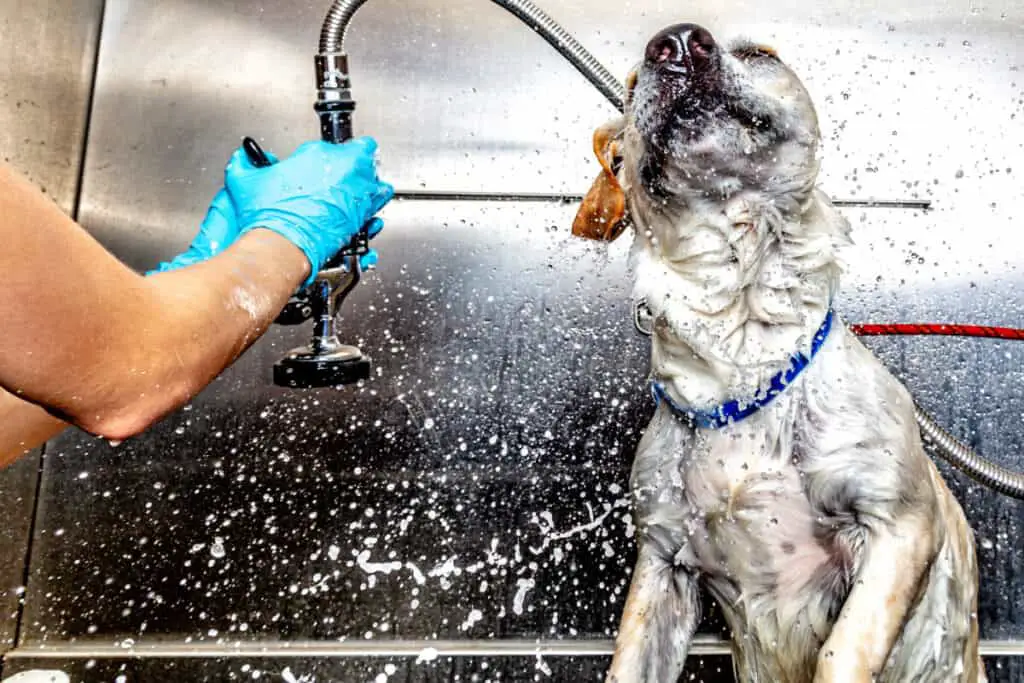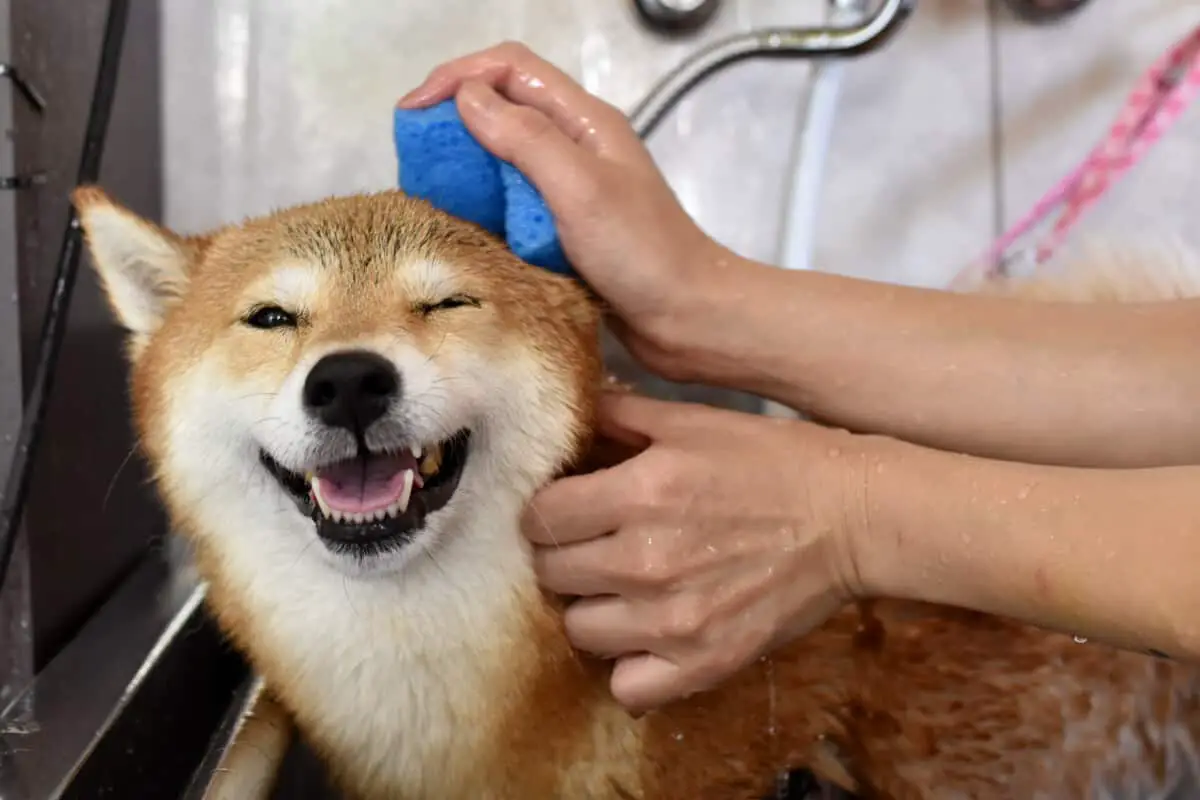Affiliate Disclosure: This post may contain affiliate links. If you make a purchase after clicking on these links I will be compensated at no extra cost to you. However, I never recommend anything I don’t love or wouldn’t use myself!
Flea dipping is the process of soaking an animal in water mixed with a specific type of flea treatment referred to as “flea dip.”
These days, most flea dips contain pyrethrin which is a natural pesticide made out of chrysanthemum flowers. This pesticide targets and shuts down the nervous system of insects by targeting glial cells.
Glial cells are packed more tightly in humans and other animals than they are in fleas. Therefore, this insecticide is extremely effective against fleas but is relatively harmless to you and your dog.
Flea dipping as a service is becoming less and less common in veterinary clinics and grooming parlors. Paying a professional for these services can cost anywhere up to $35 or more for a medium-sized dog.
It is much cheaper to do this yourself at home. This step-by-step guide will give you all you need to know in order to do so, as recommended by a professional Veterinary Technician.
However, before we begin, you should NOT flea dip a dog that is:
- below four months of age
- pregnant
- breastfeeding
1. Clean and Brush Your Dog
Flea dips work best if your dog is clean. However, many people forget to give their dog a preliminary wash before beginning the process of flea dipping.
Using lukewarm water, shampoo your dog and then rinse them thoroughly. Dry them off using a towel.
Once your dog is clean, brush them to help remove any matted fur. The flea dipping process will be more effective on a clean, unmatted coat.
2. Create the Flea Dip Mixture
Make sure to carefully follow the instructions on the bottle when mixing your flea dip solution. These instructions are there for a reason, and there can be detrimental effects if they are not followed carefully.
Use the exact ratio of water to flea dip as specified on the bottle. This is an important step because if you use too much flea dip, you can overdose your dog, which may cause neurological problems.
Similarly, if you are flea dipping a cat, you should not use a dog flea dip. Cats are more sensitive to flea dip and will overdose more easily as a result.
Make note of the type of flea dip that you have and how it actively works to kill the fleas. Some flea dips target the eggs and the reproductive cycle, while others kill the adults.
Best Store Flea Dips:
The most commonly used flea dip is Adam’s Flea and Tick Dip (Amazon): This flea dip is made with pyrethrin and targets and kills different bugs that may live on your pet. This flea dip can be found at most pet stores and is around $10.
Another great Flea Dip is the Pet MD Lime Sulfur Dip (Chewy): This flea dip is created by Veterinarians. Pet MD Lime Sulfur Dip kills fleas and other bugs, eliminates viruses, and helps with infections. This solution is around $20.
3. Apply the Diluted Flea Dip
Before beginning the next step, it’s a good idea to wear some rubber/nitrile gloves, especially if you have sensitive skin.
This step involves taking a sponge and gently applying the flea mixture to your dog. You want to be careful to not get any of the mixture into the eyes, nose, mouth, or ears of your dog.
If you are particularly worried about your dog’s eyes, you can use eye ointment first to help protect them.
When sponging your dog, you should start at the top from behind the ears avoiding the face, and work the solution into the fur, moving downward toward the tail covering everything in between. Be sure to cover the belly, armpits, legs, and paws.
After applying the solution, you can also comb the fur of your dog using a flea comb. Combing in the opposite direction may enable you to identify any eggs that may remain and will also help loosen them out of the fur.
4. Let Your Dog Dry Off

Once you have fully applied the solution to your dog let them air dry.
If needed, you can pat your dog down with a towel to remove excess water. However, do not rub them too much as the flea dip solution needs to remain on the coat for it to be fully effective.
Flea dip mixtures can be toxic if ingested so while your dog is drying, it must be kept away from small children or other animals that might lick them.
You may also want to make sure that your dog does not come in contact with the couch or other furniture around the house.
5. De-Flea Your House
Unfortunately, as with most flea prevention methods, you will have to treat your house as well as your pet.
Identify potential flea hot spots such as your dog’s bed, the couch, or any other areas where your pet frequently spends time.
Be sure to treat these areas in particular. This may include:
- Vacuuming carpets daily over the course of two weeks and throwing away the vacuum contents in an outdoor garbage can.
- Washing bedding and upholstery in the washing machine with detergent.
- Using flea sprays, or even fogging or fumigating your house.
6. Repeat the Flea Dip
Flea dips usually require another treatment anywhere between one and three weeks after the initial treatment.
The frequency at which you need to repeat the flea dip is dependent on the product that you are using so you will have to check the packaging.
For the best results, repeat steps one to four for each subsequent treatment.
7. Stop Fleas Returning With Preventative Measures
Unfortunately, flea dipping is really only effective at removing fleas that are currently residing on your dog. To prevent reinfestation and future outbreaks you should consider taking other preventative measures.
I personally use topical or spot-on treatment (view on Amazon) for my pets and I would recommend it to anyone. The treatment is placed between your pet’s shoulder blades and diffuses into their natural skin oils. It will then kill any fleas that come in contact with them for at least a month after treatment.
Some vet clinics may use an oral pill treatment. These pills have to be administered to your dog monthly and are also extremely effective. The downside is that they are typically prescription-only medications.
Aside from these types of treatments, regularly vacuuming your house, washing bedding, and using flea sprays, you may also want to reduce the chances of fleas taking up residence in your backyard.
Many insects including fleas tend to prefer damp shaded areas. By removing large pieces of debris, and keeping your lawn trimmed short you will deter fleas from living there and then reinfesting your house and pets.
What to Do if You Overdose Your Dog with flea dip
As mentioned above, if you add too much flea dip solution for the size of your dog, you can overdose them. Overdosing is dangerous because it causes neurological problems for your animal.
According to a Vet Tech, overdosing is rare, but it is seen most commonly in small dogs or cats that were given too much flea dip.
Overdose in dogs causes diarrhea, vomiting, difficulty breathing, muscle trembling, and weakness.
If you notice these signs, wash your dog with warm water and a mild detergent such as Dawn Dish Soap to stop them from getting worse, and immediately consult a veterinarian.
The veterinarians might need to use IVs, muscle relaxants, and other symptomatic care. The good news is, with proper care and immediate treatment, pets will usually make a full recovery.
When to Go to a Professional for Flea Dipping?

Although flea dipping is a process that can be done at home, there are circumstances where you should take your dog to a groomer or a vet clinic for a flea dip.
If you have skin sensitivity: The chemicals in flea dip may be irritating to your skin, so it is a good idea to go to the vet if you have any skin sensitivity.
If you do not have the proper utilities: If you do not have a big tub that you can place your dog in, or you do not have anywhere to let them dry off without bumping into anything, you should take your dog to a groomer or a vet clinic. These places will have tubs and specialized tools to flea dip your dog.
If you are older or disabled: Lifting the dog into and out of a tub can be extremely tricky, so if you have any trouble at all with that kind of thing, it is advised that you go to a groomer or a vet clinic so that you do not strain yourself.
If you are sensitive to smell: Flea dip has a strong, overpowering smell. If you have asthma, allergies, or any other breathing problem that is triggered by heavy scents, it is a good idea to take your dog to the vet and let them flea dip them.
In Conclusion
These days, flea dipping is more commonly used to treat large groups of animals such as livestock or groups of hunting dogs, particularly during hunting season.
This is mainly because it is more cost-effective to remove pests such as fleas and ticks from a large group of animals this way rather than most other options.
Flea dipping is fairly cheap if you do it at home, but it is important to follow the right steps. Hopefully, this guide has helped you in doing so.
For more information on the flea lifecycle and how to also rid your home of fleas, please check out my article How Long Do Fleas Live Without a Host? Rid Your Home ASAP.

